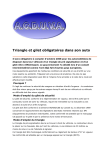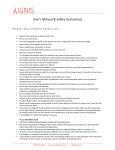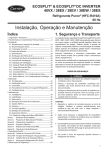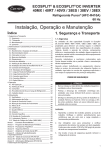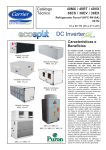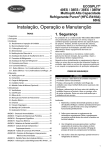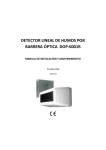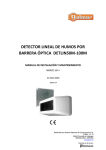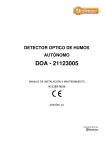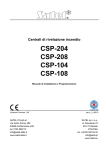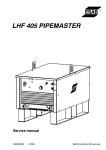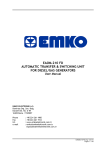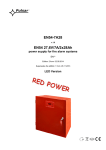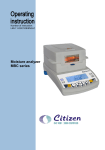Download ignis 1520m automatic fire extinguishing system controller
Transcript
IGNIS 1000 FIRE DETECTION SYSTEM IGNIS 1520M AUTOMATIC FIRE EXTINGUISHING SYSTEM CONTROLLER Installation and Maintenance Manual ID‐E294‐011GB IA Edition 2 ID‐E294‐011GB The IGNIS 1520M automatic fire extinguishing controller (control panel) covered by the present manual complies with the requirements of the following European Union Directives: CPD LVD EMC 89/106/EWG on construction materials; 2006/95/WE on electric equipment, intended for application in certain voltage range; 2004/108/WE on electromagnetic compatibility. The IGNIS 1520M extinguishing control panel has been approved with the EC‐Certificate of Conformity No. 1438/CPD/0095 issued by the Scientific and Research Centre for Fire Protection (CNBOP) Józefów, Poland, an EU notified authority No. 1438, confirming its compliance with the requirements of the PN‐EN 12094‐1:2006 standard. The certificate may be downloaded from www.polon‐alfa.pl web site. 1438 Polon‐Alfa Spółka z ograniczoną odpowiedzialnością Sp. k. 155, Glinki Street, PL 85‐861 Bydgoszcz, POLAND 07 1438/CPD/0095 EN 12094‐1 IGNIS 1520M Automatic Fire Extinguishing Controller (A class) Application – fire safety Technical data ‐ IK‐E294‐001GB manual Read the manual carefully before the detector assembling and commissioning. Any nonconformity with the instructions contained in the manual may be harmful or may cause violation of the law in force POLON‐ALFA bears no responsibility for any damage resulting from usage inconsistent with the manual. A waste product, unsuitable for further use, shall be passed to a waste electric and electronic equipment collection point. NOTE: The manufacturer reserves the right to change specifications of products at any time without prior notice. CONTENTS 1 INTRODUCTION .................................................................................................... 5 1.1 CONTENTS OF DOCUMENTATION .................................................................................... 5 1.2 CONTROL PANEL APPLICATION ........................................................................................ 5 1.3 SAFETY CONDITIONS......................................................................................................... 5 1.3.1 Anti‐shock protection ................................................................................................ 5 1.3.2 Security of systems and equipment .......................................................................... 5 1.3.3 Repairs works and maintenance................................................................................ 6 1.3.4 Fuse replacement ...................................................................................................... 6 1.4 DEFINITIONS ..................................................................................................................... 6 2 SYSTEM COMPLETENESS....................................................................................... 7 3 CONTROL PANEL TECHNICAL SPECIFICATIONS ...................................................... 8 3.1 GENERAL PARAMETERS .................................................................................................... 8 3.2 INPUTS AND OUTPUTS PARAMETERS .............................................................................. 8 4 CONTROL PANEL DESIGN ...................................................................................... 9 4.1 MECHANICAL DESIGN ....................................................................................................... 9 4.2 SIGNALLING AND HANDLING ELEMENTS, ACCESS LEVELS ............................................. 10 5 DESCRIPTION OF FUNCTIONALITIES AND CONTROL PANEL PROGRAMMING....... 10 5.1 GENERAL DESCRIPTION .................................................................................................. 10 5.2 HANDLING ELEMENTS AND INDICATORS ON FRONT PANEL ......................................... 11 5.3 HANDLING ELEMENTS INSIDE CONTROL PANEL ............................................................ 14 5.4 LCD MESSAGES ............................................................................................................... 17 5.4.1 LCD readings at the 1st and 2nd access level operation ............................................ 17 5.4.1.1 Current date and time ................................................................................................... 17 5.4.1.2 Control panel alarm mode ............................................................................................. 17 5.4.1.3 External alarm devices disablement/re‐enablement .................................................... 18 5.4.1.4 Alarm signal transmission disablement/re‐enablement ............................................... 18 5.4.1.5 Control panel operation mode information: manual control or automatic and manual control ....................................................................................................................................... 18 5.4.1.6 Fire alarm reset.............................................................................................................. 18 5.4.1.7 Testing or disablement .................................................................................................. 18 5.4.1.8 EXTINGUISHING STOP line fault .................................................................................... 18 5.4.1.9 Access denied information ............................................................................................ 19 5.4.1.10 Information on faults ................................................................................................... 19 5.4.2 Control panel functions at 2nd access level .............................................................. 19 5.4.2.1 Date and time setting .................................................................................................... 19 5.4.2.2 Line disablement setting................................................................................................ 19 5.4.2.3 Testing setting ............................................................................................................... 20 5.4.3 Control panel configuration setting programming functions (3rd access level) ...... 20 5.4.3.1 External alarm devices actuation option setting ........................................................... 21 5.4.3.2 General alarm (2nd stage) relay actuation delay programming .................................... 21 5.4.3.3 Event memory reset ....................................................................................................... 21 5.4.3.4 Evacuation alarm duration time programming ............................................................ 21 5.4.3.5 ‘Standard configuration’ loading................................................................................... 22 5.4.3.6 P1 and P2 relay programming ....................................................................................... 22 5.4.3.7 Controlling impulses duration time programming ........................................................ 23 5.4.3.8 Reset disablement time programming .......................................................................... 23 5.5 CONTROL PANEL BASIC MODES ..................................................................................... 24 5.5.1 Quiescent mode ....................................................................................................... 24 4 ID‐E294‐011GB 5.5.2 Alarm mode ............................................................................................................. 24 5.5.3 Fault mode ............................................................................................................... 27 5.5.4 Disablement mode ................................................................................................... 29 5.5.5 Testing mode ........................................................................................................... 30 5.6 SIGNAL TRANSMISSION .................................................................................................. 30 5.7 EXTERNAL ACOUSTIC ALARM DEVICES ........................................................................... 31 5.8 INPUTS AND OUTPUTS DESCRIPTION ............................................................................. 31 5.8.1 Monitoring and controlling lines inputs .................................................................. 31 5.8.1.1 Input for external EXTINGUISHING BLOCKADE buttons ................................................ 31 5.8.1.2 Input for automatic control disablement/reset ............................................................. 32 5.8.1.3 External alarm input – initiation line ............................................................................. 32 5.8.1.4 Extinguishing agent release supervision input .............................................................. 32 5.8.1.5 Pressure or mass supervision input ............................................................................... 33 5.8.1.6 RESERVE/LK line input ................................................................................................... 33 5.8.1.7 EXTINGUISHINGSTART external push buttons input ..................................................... 34 5.8.1.8 EXTINGUISHING STOP external buttons input ............................................................... 34 5.8.2 Extinguishing agent discharge controlling outputs ................................................. 35 5.8.3 Alarm devices indicators controlling outputs .......................................................... 36 5.8.4 Unsupervised non‐potential relay outputs .............................................................. 37 6 POWER SUPPLY .................................................................................................. 38 7 INSTALLATION .................................................................................................... 39 7.1 CONTROL PANEL MOUNTING ......................................................................................... 39 7.2 INPUT AND OUTPUT CIRCUITS CONNECTING TERMINALS AND WIRING SYSTEM ......... 39 8 EVENT MEMORY ................................................................................................ 40 8.1 GENERAL DESCRIPTION .................................................................................................. 40 8.2 EVENT MEMORY CONTENTS READING SOFTWARE ....................................................... 40 8.2.1 Hardware requirements .......................................................................................... 40 8.2.2 Connection between PC and control panel ............................................................. 41 8.3 EVENT MEMORY READOUT SOFTWARE RUNNING ........................................................ 41 9 CONTROL PANEL SPECIAL APPLICATIONS ............................................................ 42 9.1 EXPLOSION ENDANGERED PREMISES PROTECTION ....................................................... 42 10 OPERATION AND MAINTENANCE...................................................................... 42 10.1 GENERAL PRINCIPLES.................................................................................................... 42 10.2 PERIODICAL INSPECTIONS ............................................................................................ 43 10.3 FUSE REPLACEMENT ..................................................................................................... 43 11 PACKING, STORAGE AND TRANSPORTATION .................................................... 43 ID‐E294‐011GB 5 1 INTRODUCTION 1.1 CONTENTS OF DOCUMENTATION This Operation and Maintenance Documentation (OMD) describes the application, design and functioning of the IGNIS 1520M automatic fire extinguishing control panel. The documentation contains necessary information of the IGNIS 1520M control panels for designers, fitters and maintenance technicians. Together with the User Manual IO‐E294‐002E, intended for those who are on duty directly at the control panel, it makes the complete operating documentation attached to the control panel and delivered to its user. 1.2 CONTROL PANEL APPLICATION The IGNIS 1520M automatic fire extinguishing control panel is a single‐zone system designed for: - actuation of stationery extinguishing equipment, based on the signal from automatic detectors or manual buttons “extinguishing start ”, - warning of fire detected by detectors interoperating with the control panel, - activation of fire alarm devices, protection and sealing equipment, etc., - transmission of information on fire hazard or performance of individual stages of the automatic fire extinguishing procedure to the monitoring systems. The control panel operates with bistable (conventional) 30 and 40 series detectors, buttons for manual start, stop and disablement, and indicators manufactured by POLON‐ALFA. The panel is dedicated for installation in facilities where one extinguishing zone is required, and also may be used as a satellite control panel in bigger hierarchical systems. It is suitable for continuous operation in low‐dust rooms, at temperatures from ‐5 °C to +40 °C and relative humidity of up to 80 % at +40 °C. 1.3 SAFETY CONDITIONS 1.3.1 Anti‐shock protection The IGNIS 1520M automatic fire extinguishing control panels are ranked as 1st protection class devices and can be used only in the case of application of additional protection against electric shocks, such as zeroing or protective grounding. Insulation of the 230 V/50 Hz power circuits is reinforced and resists the test voltage of 2800 V. Insulation of low‐voltage circuits (below 42 V) resists the test voltage of 700 V DC. After connecting the mains power supply cabling, the mains connection must be protected with a manufacturer's shield. 1.3.2 Security of systems and equipment The wiring installation should be made of wires with the required fire resistance and it should be properly protected when crossing the fire zone borders. In order to prevent unwelcome effects, the distance between the low‐voltage installation and the power and lightning protection systems should be kept as required. Taking into account system resistance to electromagnetic interference, it is recommended to use protective grounding. A reserve batteries cluster must be connected to the unit during the final installation process stages. The components of this unit are high‐temperature sensitive. The maximum ambient temperature must not exceed 40 °C. It is forbidden to block the ventilation openings on the side of the unit. The space around the unit must facilitate free flow of air. The air humidity in the rooms where the unit operates must not exceed 95 %. 6 ID‐E294‐011GB 1.3.3 Repairs works and maintenance The maintenance works and periodical inspections should be conducted by the authorised employees of companies which have been authorised or trained by Polon‐Alfa personnel. All repair works must be done exclusively by the manufacturer. Polon‐Alfa does not bear any responsibility for the operation of devices maintained and repaired by unauthorised personnel. 1.3.4 Fuse replacement When replacing fuses, use only spare parts of the appropriate type and nominal value. See point 10.3 for appropriate types and nominal values. 1.4 DEFINITIONS Actuation mode – a status of the control panel whereby actuation of the extinguishing control procedure is signalled. Discharge mode – a status of the control panel whereby discharge of the extinguishing agent into the protected premises is signalled. Alarm mode – a status of the control panel whereby a fire alarm is signalled. Disablement mode – a status of the control panel whereby a disablement of one or more functions is signalled. Testing mode – a status of the control panel whereby the function checking (testing) is signalled. Fault mode – a status of the control panel whereby any fault in the fire protection system is signalled. Warning time before discharge (delay of the extinguishing signal) – a time from the actuation of fire extinguishing (signalled by the red “extinguishing start ” diode) until the release of extinguishing agent, in order to warn the people at danger. Detection line – a two‐wire line with fire warning devices attached and ended with an end‐of‐line resistor. Detection zone – an area supervised by the fire warning devices for which alarm devices are allocated in the fire detection and alarm system. Monitoring line – a two‐wire line to supervise control contacts of the external fire fighting equipment. Controlling line – a two‐wire monitored line to actuate specific functions in the fire fighting equipment. Fire warning device – a fire detector. EXTINGUISHING START button – a button used to manually actuate the automatic fire extinguishing procedure. EXTINGUISHING STOP button – a button operative only during warning of discharging (evacuation alarm), used to stop the extinguishing agent release. EXTINGUISHING DISABLEMENT button – a button used to hold or disable the fire extinguishing procedure in any operating mode of the control panel. RESERVE START button – a button used to actuate manually an additional extinguishing agent discharge, but the reserve actuation is only possible after the basic discharge has been completed. Standard configuration (factory settings) – a set of data saved in the control panel memory defining parameters of the functions to be programmed by the user (e.g. transmission delay time, evacuation alarm duration). ID‐E294‐011GB 7 Extinguishing device – a set of the extinguishing agent tanks, pipelines and nozzles arranged in such the way that the extinguishing agent will be distributed within the protected area so that the appropriate extinguishing concentration is obtained. Self‐acting equipment – equipment operating without human interference. Manual activation – activation that requires human interference. Output to the monitoring system – a relay output from the control panel which allows transmitting the fire and fault signals to the monitoring centre or fire brigade. 2 SYSTEM COMPLETENESS Table 1 specifies the equipment delivered in complete with the control panel. Table 2 specifies the equipment for typical fire alarm systems, operating with the control panel in the IGNIS 1000 system, to be ordered separately in required quantities. Table 1 Item Description Quantity (pcs) 1 IGNIS 1520M fire extinguishing control panel 1 2 Operation and maintenance manual (I&MM) ID‐E294‐011E 1 3 Warranty certificate 1 4 Control panel package 1 Table 2 Item Description Remarks 1 Battery 12 V/7 Ah 2 pcs necessary for a control panel 2 PU‐61 EXTINGUISHING START push button Yellow colour – in accordance with a separate specification 3 PW‐61 EXTINGUISHING STOP push button Blue colour – in accordance with a separate specification 4 PD‐61 START RELEASE push button Green colour – in accordance with a separate specification 5 PB‐61 EXTINGUISHING DISABLEMENT push button White colour – in accordance with a separate specification 6 PU‐61, PW‐61, PB‐61 push button instructions On photo‐luminescent material to be placed near the push button 7 SD‐1 door signalling element With wording „CAUTION! GAS! DO NOT ENTER!” 8 SO‐1 optical signalling element With wording „CAUTION! AUTOMATIC ESTINGUISHING! LEAVE THE PREMISES!” 9 30, 40 model range conventional detectors (also in intrinsically safe execution) In accordance with a separate specification 8 ID‐E294‐011GB 3 CONTROL PANEL TECHNICAL SPECIFICATIONS 3.1 GENERAL PARAMETERS Overall dimensions L x H x G Mass (without batteries) Ingress protection Operation temperature range Admissible operating relative humidity Transportation temperature range Supply voltage: 50 Hz mains HP7‐12 KOBE battery (or equivalent) 314 x 368 x 106 mm < 6 kg IP 30 ‐ 5 °C ÷ + 40 °C 95 % at + 40 °C ‐ 25 °C ÷ + 55 °C Number of detection zones Power consumption in quiescent mode: • from the mains in the buffering/charging mode, max • from battery, after mains voltage outage, max • from battery, after mains voltage outage, typical 1 Power consumption while alarming: • from the mains in the buffering/charging mode, max • from 7Ah battery, max External devices supply voltage Admissible power consumption from the power supply unit (24 V): • within <0.5 h • permanently Max power consumption by external devices in quiescent mode, which allows obtaining a pre‐set the system operation time in case of mains voltage outage: • with internal 7 Ah battery for 30 h • with internal 6.5 Ah battery for 30 h • with internal 7 Ah battery for 72 h 230 V + 10 % ‐ 15 % 2 x 12 V / 7 Ah 100 mA/800 mA 90 mA 75 mA 200 mA/800 mA 3A 24 V ± 15 % 3A 2A 125 mA 110 mA 0 mA (current draw only in alarm mode) The above‐mentioned data correspond to the assumption that the load of detection, monitoring and control lines in the quiescent mode is at its maximum and the control panel will additionally draw an average current at 1 A for 0.5 h when in the alarm mode. 3.2 INPUTS AND OUTPUTS PARAMETERS Detection lines: • quantity • resistance, max • line insulation resistance, min • number of detectors per line, max • end‐of‐line resistor value • detection current per line, max • total detection current per line, max 2 2 x 120 Ω 100 kΩ 32 5.6 kΩ ± 5 %; 0.25 W 2 mA 7 mA Monitoring and controlling inputs: • quantity • resistance of an attached line, max • insulation resistance of the attached line 8 2 x 50 Ω >100 kΩ ID‐E294‐011GB • end‐of‐line resistor value 9 10 kΩ ± 5 %; 0.25 W Supervised relay outputs: • quantity • resistance of an attached line, max • insulation resistance of the attached line • end‐of‐line resistor value • current load capacity of P9, P10, P11 outputs • current load capacity of P6, P7, P8 outputs • output voltage in an active mode 6 2 x 50 Ω >100 kΩ 5.6 kΩ ± 5 %; 0.25 W 1A 2A 24 V ± 15 % Non‐potential unsupervised relay outputs: • quantity • current load capacity of contacts 11 1 A 24 V Time parameters of programmable outputs and control inputs: • general alarm transmission delay (P5, P17) • extinguishing signal delay (evacuation time – P10) • time of the extinguishing agent discharge control impulse: - P6 relay - P7 relay - P8 relay • delay times for P1, P2 programmable relays • time of entering the actuation state after pressing the bush‐button EXTINGUISHING START programmable every 1 s programmable every 1 s 0 ÷ 10 min, 0 ÷ 1 min, programmable every 1 s programmable every 1 s programmable every 1 s programmable every 1 s 0 ÷ 30 min, 0 ÷ 30 min, 0 ÷ 30 min, 0 ÷ 10 min, <3s 4 CONTROL PANEL DESIGN 4.1 MECHANICAL DESIGN The control panel is made in the form of a metal cabinet intended for wall mounting. The front of the control panel is the door with manipulation and signalling elements on. The door can be opened after two clamping bolts are unscrewed. The key switch does not act as the mechanical lock. Inside the control panel, in its bottom part, a space for battery pack is provided. The control panel controller motherboard with linear circuits is mounted on the internal side of the door. On the rear wall of the casing, there are glands to insert the alarm system cables and power cables, and the board with supply circuits and connecting blocks. In the left side wall, there is a plugged hole which enables inserting the cable for connection with PC and transferring the control panel events memory contents via the RS serial interface. 10 ID‐E294‐011GB 4.2 SIGNALLING AND HANDLING ELEMENTS, ACCESS LEVELS The signalling and handling elements are located on the control panel door, hereinafter also referred to as the front panel. The following elements are available on the front panel: LEDs, backlight indicator with the FIRE wording, key switch, membrane buttons and special push buttons: EXTINGUISHING START and LOCK EXTINGUISHING with a transparent shield to prevent from an unintentional press. In the upper part of the front panel, the LCD is mounted. Every signalling and manipulation element has its own description. The handling and signalling elements distribution is shown in fig. 1 and for their detailed description is contained in point 5.2. The manipulation elements, which enable changing the configuration parameters, are provided inside the control panel as buttons located immediately on the controller’s printed board. On the PCB, there is also the restart button and set of contacts for programming the control panel operation by means of ZW3...ZW12 jumpers. On the rear wall of the control panel, there is the power supply board with 24 V converter module, converters for voltages necessary for supplying the electronic systems, battery pack charging system and a set of connecting blocks for connection of internal wiring systems. Next to the connecting blocks, there are ZW1 jumpers and a connecting block with 24 V output for the external equipment supplying. Over the mains adaptor module, there is the 230 V double‐pole power switch, and under the screwed‐in screen plate – the mains connecting block. In IGNIS1520M control panel, the accessibility of the handling elements and specific functions is diverse and divided into four access levels. The 1st access level is intended for persons who take the first measures after a fire alarm or fault has been signalled. On this access level, only two push buttons are active: the “acknowledgement” button and the signalling element test function enabled by the button “manual/automatic and manual control”. The 2nd access level is intended for those who are particularly responsible for security and have been trained and authorised to operate the control panel to a limited extent. To enter the 2nd access level, it is necessary to turn the key. This makes all the buttons on the control panel front panel available. The 3rd access level is intended for those who are trained and authorised to change the configuration data and perform the maintenance. This access level handling elements are located inside the control panel. The 4th access level is intended for those who are trained and authorised by the manufacturer to change the factory software and perform the servicing. 5 DESCRIPTION OF FUNCTIONALITIES AND CONTROL PANEL PROGRAMMING 5.1 GENERAL DESCRIPTION The IGNIS 1520M control panel combines the functions of the fire detection and alarm system and the universal automatic extinguishing controller. It is equipped with two conventional detection lines, eight inputs for supervised monitoring and controlling lines, six supervised outputs to control the alarm devices circuits and devices initiating the release of extinguishing agent, set of eleven relays with non‐potential change‐over contacts and clench contacts for performance of executive functions and the control panel mode monitoring functions. ID‐E294‐011GB 11 In the section responsible for fire detection, two‐line coincidence was used as one of the most effective methods to eliminate false alarms. The additional way to immunize the system against detector false actuation is a possibility to programme the variant with preliminary reset. In the fire extinguishing controlling section, the extinguishing agent discharge is possible after the simultaneous occurrence of two independent signals on the outputs of separate systems. In the case of a fault of the microprocessor circuit, the operation of relays that control the extinguishing agent discharge is also disabled. In the only‐manual mode, when the alarm signal comes from fire alarm warning devices installed in the detection lines, the alarm signalling is carried out in two steps. The control panel first triggers the 1st stage (preliminary) alarm and then, after the delay time, the 2nd stage (main) alarm, without actuation of the automatic fire extinguishing procedure. In the automatic control mode, the detectors triggering does not result in the automatic fire extinguishing procedure actuation unless there has been a two‐line coincidence, that is an actuation of at least two detectors in two detection lines. In the case of fire detection by the attending personnel, the control panel always enables the manual alarm evoking and activation of the automatic fire extinguishing procedure with buttons EXTINGUISHING START . The extinguishing procedure starts with actuation of the evacuation signal and counting down the programmed discharge delay time. In this time, it is possible to stop the countdown and increase the discharge delay by pressing the EXTINGUISHING STOP push button. After this delay time elapses, the electric impulse is sent to discharge the extinguishing agent and actuate relevant warning signals against entering the room. At the right moment during the extinguishing procedure execution, the control panel can actuate the sealing equipment (e.g. smoke dampers) to maintain the correct concentration of extinguishing agent within a pre‐set time. The warning signals are active until the alarm has been reset in the control panel. The button EXTINGUISHING BLOCKADE is installed in the control panel to enable discharge blocking in any operating mode of the system. All the necessary indicators of the control panel are located on the control panel front side in the form of illuminating diodes with descriptions. The LCD display has an auxiliary function with regard to signalling. It is mainly used to enter the parameters determining the operation conditions of the control panel and enables monitoring of the real‐time clock operation. Most events the control panel is able to detect are saved in the internal events memory. 5.2 HANDLING ELEMENTS AND INDICATORS ON FRONT PANEL In the further part of this section, for easier identification, before the description of every element its number is given in the brackets according to the marking as in fig. 1. 12 ID‐E294‐011GB Fig. 1 Front panel view (1) FIRE The distinctive optical red indicator signals fire detection by a flashing light of ca. 1 Hz frequency. Labelled as FIRE, this indicator is lit during the 1st and 2nd level fire alarms. By pressing the button “ACKNOWLEDGEMENT” the light is changed from flashing to continuous. (2) EXTINGUISHING START A red indicator signals with: • a flashing light – a state before actuation (an alarm in one detection line), • a permanent light – actuation state (actuation of the automatic fire extinguishing procedure as a result of alarming by two detection lines or manual actuation). (3) EXTINGUISHING STOP A yellow diode signals with permanent light suspension of counting down the extinguishing agent release delay time at the discharge warning stage after pressing the EXTINGUISHING STOP button. (4) EXTINGUISHING BLOCKADE ID‐E294‐011GB 13 A yellow diode signals with permanent light the fire extinguishing disablement state – prevention from the extinguishing agent discharge. (5) DISCHARGE A red diode signals with: • a permanent light – discharge state (the extinguishing agent release), • a flashing light – efficiency status of tested monitoring and controlling line. (6) TRANSMISSION A red diode signals with permanent light that the general alarm relay contacts are switched to the active position. (7) MANUAL CONTROL A button for the control panel operating mode switchover: • manual control (personnel present), • automatic control, but with a possibility of manual control (personnel present or absent). A yellow diode (7) signals with permanent light the manual operation mode. The button has additionally another function – actuation of the control panel indicators testing. To enable this function, it is necessary to switch the control panel to the 1st access level (key not turned) and press the (7) button for > 4 sec. Testing should be disabled after approx. 8 sec or after a short pressing of the button once again. (8) ACKNOWLEDGEMENT A button for the acoustic indicators silencing and acknowledgement of the acceptance of fire alarms by the personnel; active at the 1st access level (without turning the key). When pressed for a longer time (> 5 sec), it has another function – it initiates sending information from the events memory to RS output. (9) RESET A button for the alarm mode cancelling in the control panel and detectors in detection lines. (10) EXTINGUISHING START A button for manual activation of the automatic fire extinguishing procedure. (11) EXTINGUISHING DISABLEMENT This button enables or disables the extinguishing agent discharge (or release interruption). Remark: The EXTINGUISHING START and EXTINGUISHING DISABLEMENT push buttons installed in the control panel are operative at the 2nd access level. (12) PERSONNEL ACCESS A key switch that changes the access level from the 1st one to the 2nd one – actuates the handling elements intended for use at the 2nd access level (all the buttons on the front panel). A yellow diode at the key switch signals with: • a permanent light – enabled personnel access, • a flashing light – disabled operation of the EXTINGUISHING START push button when the control panel door is opened. (13) POWER SUPPLY A green diode signals with permanent light that at least the mains or battery power supply is on. (14) DISABLEMENT A yellow diode signals collectively disablement of at least one circuit or function (disablement mode). (15) TESTING A yellow diode signals collectively testing of at least one circuit or function (testing mode). (16) FAULT A yellow diode signals collectively a fault of at least one circuit or function (fault mode). 14 ID‐E294‐011GB (17) Three yellow diodes indicate a fault of: POWER SUPPLY • a permanent light – a battery fault or charging circuit fault, • a flashing light – the mains fault, SYSTEM • a permanent light – a microprocessor circuit function fault or false configuration data, EARTH FAULT • a permanent light – an earth fault of any of the control panel monitored output circuits. In the FAULT/DISABLEMENT/TESTING field, there are 9 yellow diodes (18) ÷ (27), which signal: • a fault – with a “slow” flashing light (approx. 1 Hz), • a disablement – with a permanent light, • testing – with a “fast” flashing light (approx. 10 Hz), (19) DETECTION LINE 2, (20) INITIATION LINE, (21) MANUAL CONTROLLING DEVICES ‐ for monitoring and controlling lines: extinguishing start , extinguishing stop , extinguishing blockade, reserve actuation, automatic control/reset disablement, (22) ELECTRO‐VALVES – P6, P7, and P8 relay lines, (23) DISCHARGE MONITORING, (24) PRESSURE/MASS SUPERVISION, (25) EXTERNAL DEVICES related to a fault of: • the LK monitoring line, • an external devices power supply fuse; related to a disablement of: • a monitoring line, • the P1, P2 relays; (26) TRANSMISSION related to a disablement of the P5 and P17 relays, (27) External ALARM DEVICES – related to the P9, P10, P11 relays. Nearby the (26) and (27) diodes, there are buttons for: • the P5 and P17 general alarm relays disablement/re‐enablement (transmission disablement), • the P9, P10, P11 acoustic alarm devices controlling relays disablement/re‐enablement. (28) LCD (for description see point 5.4) (29) FUNCTION A button for switching functions such as disablement, testing, date and time setting (with use of LCD), which are executable after the control panel is switched to the 2nd access level. (30) SELECT A button for changing the cursor position on LCD – a function parameter selection. (31) SET A button for changing the value of the selected function parameter. 5.3 HANDLING ELEMENTS INSIDE CONTROL PANEL Inside the control panel, on the main PCB, there are the following handling elements, which are available when the door is opened (Fig. 2). For the functions of ZW3…ZW10 and ZW12 jumpers, see table 1. ID‐E294‐011GB 15 Fig. 2 FUNCTION, SELECT, SET – three buttons inside the control panel (the 3rd access level), which enable the control panel configuration settings programming; RESET – a button to restart the control panel controller; ZW1 – a jumper on the power supply board, next to the connecting blocks – switching on/off the earth fault monitoring circuit; BZ1 – 3.15 A – the battery pack circuit protection; BZ2 – 3.15 A – protection of power supply circuit + 24 V of external devices and relay outputs + 24 V; WŁ. AKU – a button on the power supply board – enables switching on the control panel when the mains power is off; R3 – LCD contrast adjustment; Wł. – a double‐pole power switch, mounted over the power supply device. Table 1 Jumper No. ZW3 ZW4 Function Sets the P12 relay actuation criterion (connecting block No. 33‐34) Sets the input actuation function (connecting block No.3‐4) Jumper position Actuation description 1‐2 P12 relay closes contacts together with switching the control panel to the 2nd or 3rd access level (the key turned or the control panel door open) 2‐3 P12 relay closes contacts in the control panel manual control mode 1‐2 The line active status entails automatic control disablement (enables remote control mode switch over from only manual one to automatic/manual and reversely) 2‐3 The line active status entails the control panel automatic control reset (enables performance of remote alarm mode reset function) 16 ZW5 ZW6 ZW7 ZW8 ZW9 ZW10 ID‐E294‐011GB Sets the P13 relay actuation criterion (connecting block No. 35‐36) Sets extinguishing function execution of the EXTINGUISHING STOP function (connecting block No. 15‐16) ‘Discharge monitoring’ line switch on/off (connecting block No. 7‐8) Sets detection lines alarm variant Sets the LK/RESERVE input function actuation (connecting block No. 11‐12) 1‐2 P13 relay closes contacts in the DISCHARGE state, basing on P6 relay (which controls an electro‐valve) actuation information 2‐3 P13 relay closes contacts in the DISCHARGE state, basing on a genuine release signal received from the ‘release supervision’ line 1‐2 The EXTINGUISHING STOP push button pressing causes an extinguishing signal disablement and a break in evacuation time countdown. Releasing the push button will entail the extinguishing procedure resumption and counting down a pre‐set evacuation time from the beginning. 2‐3 The EXTINGUISHING STOP push button pressing causes an extinguishing signal disablement but does not break the evacuation time countdown. Releasing the push button will result in immediate extinguishing signal transmission to the extinguishing agent releasing devices. In case the extinguishing procedure is resumed before the pre‐set evacuation time elapse, the extinguishing signal transmission is carried out after the elapsing time complete countdown. 1‐2 The ‘discharge monitoring’ line switched on but does not require an end‐of‐line resistor connection 2‐3 The ‘discharge monitoring’ line switched on. The extinguishing agent release signal being sent to the line causes the control panel entering the discharge mode (see p.5.5.2 – discharge mode description). Lack of the extinguishing agent release signal from the line during the automatic extinguishing procedure performance, will result in ‘no discharge’ signal indication 1‐2 Alarm without preliminary detector reset. 2‐3 Variant without the detection line 1 and detection line 2 preliminary detector reset. 1‐2 The line performs the universal monitoring line (LK) function 2‐3 The line performs the RESERVE push buttons line function 1‐2 The controlling and monitoring line testing switch off (clamps 1...16) – quiescent mode (normal line operation status) 2‐3 Switching on the controlling and monitoring line testing switch off (clamps 1...16) and alarm devices (P9, P10, P11); a possibility to switch on electro‐valve (P6, P7, P8) relays Testing on/off ID‐E294‐011GB 17 actuation is blocked in a ‘hardware’ sense. Testing procedure requires additional setups on the LCD. After pressing the ACKNOWLEDGEMENT push button, the control panel software version is displayed – at the 1st access level (the key in off position). 1‐2 ZW12 Unused 2‐3 5.4 LCD MESSAGES The IGNIS 1520M control panel is equipped with a 16‐character alphanumeric LCD (28). The main task of the display is to enable setting and reading of the real time, date and the control panel configuration parameters. The current time and date are used in the automatic event recording system. The control panel basic modes are indicated by illuminating diodes, while the display provides only an auxiliary function in this regard. The display additionally supports the control panel operation by showing messages about its status or active buttons functions. During the control panel operation in a quiescent mode, the LCD displays the date and time. Any other information, except for an alarm mode, is displayed on a temporary basis. After several seconds, the control panel automatically returns to displaying the date and time. 5.4.1 LCD readings at the 1st and 2nd access level operation 5.4.1.1 Current date and time ‐ exemplary display: 05 – 12 – 31 23 : 59 (year‐month‐day hour : minute) 5.4.1.2 Control panel alarm mode The 1st and 2nd stage alarm: L.2 ALARM ! 0’00 where: - L2 ‐ number of the line, where an alarm has been detected (the alarm, that has occurred as the first one, is indicated by a flashing line number); - 0’00 ‐ current fire alarm transmission delay time, (range – 0’00...9’59). Extinguishing actuation state (evacuation alarm stage) EVAC.TIME – 0’23 18 ID‐E294‐011GB where: - 0’ 23 – current time left until the extinguishing agent is released (counted in seconds), Discharge state (fire extinguishing stage) EXTINGUISH‐00 ’ 04 where: - 00’ 04 – counted in seconds the extinguishing agent discharge time (control impulse time, in sequence from the P6, P7 and P8 relays, when the extinguishing agent additional reserve is activated). 5.4.1.3 External alarm devices disablement/re‐enablement ALARM DEV. ON ALARM DEV. OFF 5.4.1.4 Alarm signal transmission disablement/re‐enablement TRANSMISSION ON TRANSMISSION OFF 5.4.1.5 Control panel operation mode information: manual control or automatic and manual control CONTROL MANUAL CONTROL AUTO/MAN 5.4.1.6 Fire alarm reset RESET 5.4.1.7 Testing or disablement TEST or DISABL. This information is displayed: - when the ZW10 jumper (item 2‐3) has been switched to the monitoring and controlling lines testing mode, - at an attempt of fire extinguishing manual activation with the control panel open door. 5.4.1.8 EXTINGUISHING STOP line fault FAULT STOP LINE Information displayed at an attempt of fire extinguishing activation with the EXTINGUISHING START push button when the EXTINGUISHING STOP push buttons line is in a fault mode. ID‐E294‐011GB 19 5.4.1.9 Access denied information LACK OF ACCESS Displayed at an attempt to activate any of the buttons operating at the 2nd or 3rd access level, when the key (35) has not been turned. 5.4.1.10 Information on faults The possible displayed information is described in p.5.5.3 ‘Fault mode’. 5.4.2 Control panel functions at 2nd access level With the FUNCTION, SELECT, SET push buttons available at the front panel, the following actions are possible: to set the date and time, to set a disablement, to set testing of detection lines, monitoring and controlling lines, alarm devices. To call a desired function, the FUNCTION push button should be used. The modifiable item is indicated by a flashing cursor. The cursor position can be changed with the SELECT push button. To modify the selected value, use the SET push button. The SELECT push button allows moving the cursor to the right only. To return to the beginning of the display, you must go through all the settable items. The SET push button functions in the same way. 5.4.2.1 Date and time setting In order to set the current date and time, you should first enable the function “date and time setting” with the FUNCTION push button. 03 – 12 – 31 23 : 59 (year‐month‐day hour : minute) The date with a blinking digit (tens of year) should be visible on the display. The blinking digit means that it can be modified with the SET push button. The SELECT push button moves the setting function onto the next digit. In this way, you can set, one by one, all the digits to display the current date and time (e.g. 03‐12‐31 23:59). In order to keep the clock operating when the supply voltage is off, the control panel is equipped with a lithium battery mounted on the controller board. 5.4.2.2 Line disablement setting Any disablement/re‐enablement requires: to select one of the following option on the LCD using the FUNCTION push button: DISA. DET. L.1 – 0 • set the name of a disabled circuit (according to Table 2) using the SET push button, • enter “1” – disablement or “0” – re‐enablement using the SELECT and SET buttons. The list of circuits that can be disabled is presented in Table 2: Table2 Message on LCD Disablement description Clamps 20 ID‐E294‐011GB Message on LCD Disablement description Clamps DISA. DET. L. 1 ‐ 0 Detection line 1 disablement 17‐18 DISA. DET. L. 2 ‐ 0 Detection line 2 disablement 19‐20 DISA. START L. ‐ 0 EXTINGUISHING START push button disablement 13‐14 DISA. STOP L. ‐ 0 EXTINGUISHING STOP push button disablement 15‐16 DISA. BLOCK. L. ‐ 0 EXTINGUISHING BLOCKADE push button disablement 1‐2 DISA. BL.AUTO L ‐ 0 Disablement of automatic control blocking line/reset 3‐4 DISA. INIT. L. ‐ 0 Disablement of initiating line – external alarm input 5‐6 DISA. DISCHAR. L ‐ 0 Disablement of discharging line 7‐8 DISA. PRESS/M. L. ‐ 0 Disablement of pressure/mass supervision 9‐10 DISA. RESERVE L ‐ 0 Disablement of extinguishing agent reserve release line 11‐12 DISA. of P6, 7, 8 ‐ 0 Disablement of P6, P7, P8 relays (that control electro‐valves) 21‐26 Disablement of P1, P2 relays 41‐46 DISA. of P1, 2 ‐ 0 5.4.2.3 Testing setting In order to set the testing mode, it is necessary to: - select one of the following option on the LCD using the FUNCTION push button: TEST DET. L. 1 – 0 • set the name of a tested circuit (according to Table 3) with the SET push button, • enter “1” – testing or “0” – return to quiescent mode with the SELECT and SET push buttons. The list of the control panel circuits with the testing function is provided in Table 3: Table 3 Message on LCD Testing description Clamps TEST DET. L. 1 ‐ 0 Detection line 1 testing 17‐18 TEST DET. L. 2 ‐ 0 Detection line 2 testing 19‐20 TEST M. LINES ‐ 0 Testing of controlling and monitoring lines * 1‐16 TEST P9, 10, 11 ‐ 0 Testing of signalling devices (P9, P10, P11 relay outputs)* 27‐32 (*) ‐ test possible when the ZW10 jumper is switched over 5.4.3 Control panel configuration setting programming functions (3rd access level) In order to use those functions it is necessary to unscrew two bolts on the front panel and open the control panel door. This is frequently referred to as the 3rd access level. On the PCB inside of the door, there are three push buttons: FUNCTION, SELECT and SET (Fig. 2), which are used to set delay times, duration of output pulses and the control panel other configuration parameters. The values ID‐E294‐011GB 21 displayed on LCD are saved automatically. On the same board, there is also the RESET button, which is necessary for execution of certain functions. The display readings presented below are exemplary. 5.4.3.1 External alarm devices actuation option setting The IGNIS 1520M control panel is equipped with a supervised output for external alarming devices connection – marked as P9 (terminals 27, 28). The operation way of this output depends on the programmed option – as described in point 5.7. EXT. AL. OPT. – 0 where: 0 –option number (0 or 1) In order to change an option, it is necessary to select the following wording on the display: OPTION. AL. EXT. – 0, and settle one of two options “0” or “1” with the SELECT and SET push buttons. 5.4.3.2 General alarm (2nd stage) relay actuation delay programming In the manual control mode, the control panel allows the personnel on duty to verify a fire occurrence. The duty officer is required to report within 30 sec and confirm the alarm by pressing the ACKNOWLEDGEMENT push button. When the duty officer fails to confirm the alarm within this time, the control panel will actuate the alarm transmission relays. After the alarm has been confirmed, the control panel counts down the delay time necessary for recognition of the real hazard within the facility. The delay time is programmable using the following function: DELAY 1’ 30” where: 1’ – minutes (0...9), 30” – seconds (0...59) Every digit is set independently with the SET push button. The SELECT button moves the cursor to the next digit. 5.4.3.3 Event memory reset In order to erase the event memory contents, it is necessary to call the MEMORY RESET – 0 function using the FUNCTION button and with the SET push button to switch the option from “0” to “1”, EVENT MEM. RES. ‐ 0 where: 0 means the erasing function switch off, and 1 means the erasing function switch on. The event memory contents will only be erased upon restarting the control panel controller with the RESET push button. A failure to restart (with the RESET button) within 10...20 seconds since entering “1” will automatically reset the “1” option and the memory will not be erased. 5.4.3.4 Evacuation alarm duration time programming In order to change the duration of evacuation alarm, it is necessary to call the EVAC. DURATION function using the FUNCTION push button. EVAC. TIME ‐ 0’ 20 where: 0’ – minutes (0...1), 22 ID‐E294‐011GB 20 – seconds (0...59) The SELECT push button enables moving the cursor to a position of the value to be modified. The value in selected position can be modified with the SET push button. 5.4.3.5 ‘Standard configuration’ loading The IGNIS 1520M control panel supplied to the user, is preliminary programmed by the manufacturer as to its operation conditions, what is referred to as the standard configuration. The control panel user programming changes the factory settings in order to optimally adjust the parameters to the system needs and characteristics of the protected facility. The control panel is furnished with functions that enable automatic cancellation of the user settings and restoring the standard configuration. The standard configuration loading requires: - to open the control panel, - to use the internal FUNCTION press button (by pressing it several times) for selection of the STANDARD CONF. – 0 option on the display:, - to switch over from “0” to “1” with the SET push button, - to restart the control panel with the RESET push button. STANDARD CONF.– 0 where: 0 – means disabling the “standard configuration” download function, and “1” – means enabling the “standard configuration” download function. After the above‐mentioned operations performance, the control panel parameters are programmed as follows: detection lines – switched on, 2nd stage alarm delay time set to 1 min 30 sec, external alarm option – 0, evacuation time – 1 min, delay time for P1, P2 relays actuation– 10 sec, actuation criterion for P1 relay – 1st stage alarm, actuation criterion for P2 relay – 2nd stage alarm, P6 impulse duration – 4 sec, P7 impulse duration – 4 sec, P8 impulse duration – 4 sec, TRANSMISSION, ALARM DEVICES – enabled, CONTROL – switched to “automatic and manual” one. A failure to restart (with the RESET button) within 10...20 seconds since entering “1”, will automatically reset the “1” option and the Standard configuration will be entered. 5.4.3.6 P1 and P2 relay programming In order to programme the P1 and P2relays, select function PK1 ‐ AL. I ‐ 0'10 with the FUNCTION push button and then use the SET and SELECT buttons to set the number of relay to be programmed, actuation criterion and delay time. PK1 – AL. I ‐ 0’ 10 where: PK1 – P1 (or P2) relay, AL I – actuation criterion for P1 (or P2 relay) . ID‐E294‐011GB 23 The actuation criterion for the P1 (and independently for P2) relay can be programmed by selecting the relevant event (1st stage alarm, 2nd stage alarm, extinguishing start , etc.) according to Table 4. Table 4 Message on LCD Relay actuation description PK1 ‐ AL. I ‐ 0'10 The relay actuation after a 1st stage alarm triggering and a pre‐set delay countdown, until the alarm reset. PK1 ‐ AL. I I ‐ 0'10 The relay actuation after a 2nd stage alarm triggering and a pre‐set delay countdown, until the alarm reset. PK1 ‐ START ‐ 0'10 The relay actuation after the control panel extinguishing procedure evoking and a pre‐set delay countdown, until the alarm reset. PK1 – DISCH. ‐ 0'10 The relay actuation after the extinguishing agent discharge and a pre‐set delay countdown, until the alarm reset. PK1 ‐ RESET ‐ x'xx The relay actuation during alarm reset (ca. 3 sec); disablement of a delay programming possibility. PK1 ‐ 0 ‐ x'xx The relay inactive (switched off) 5.4.3.7 Controlling impulses duration time programming In order to change the duration of the extinguishing agent release impulses, it is necessary to call the function “time 1 (P6) 00’04” with the FUNCTION push button. TIME 1 (P6) ‐ 00’ 04 where: 1 (P6) – impulse No. (1..3) and a relay description (P6...P8) 00’ – minutes (0...29), 04 – seconds (0...59). This function allows to programme 3 duration values for the P6, P7 and P8 releasing impulses (supplying 24 V current through relay contacts). The SELECT push button should be used to move the cursor to the position to be modified. The value in selected position can be modified using the SET button. 5.4.3.8 Reset disablement time programming The control panel enables to disable a possibility of an activation state reset for a specific time (0...30 min) using the “reset disablement” function. In order to change the duration of the reset disablement, it is necessary to call the “DISA.RES. t= 00’00” function with the FUNCTION push button and use the SELECT and SET push buttons to programme the desired time. DISA. RES. T = 00'30 where: 00’ – minutes (0...29), 30 – seconds (0...59) 24 ID‐E294‐011GB 5.5 CONTROL PANEL BASIC MODES 5.5.1 Quiescent mode In the quiescent mode, i.e. while the control panel is waiting for a signal from fire warning devices, only the green POWER SUPPLY diode is lit on the front panel to inform that power supply is on. In addition, the current time and date are displayed on LCD. All the control panel relays are inactive, except for the general fault relay, which is in an actuation state. 5.5.2 Alarm mode The control panel fire hazard detection part enables a two‐stage alarm arrangement, i.e. it allows to delay actuation of the outputs to fire alarm transmission devices so that the evoked fire alarm can be verified by the personnel. The alarm occurring during the verification until the alarm signal transmission relays are triggered is called a preliminary alarm, an internal alarm or a 1st stage alarm. The 2nd stage (external or general) alarm takes place after the alarm transmission relays are triggered. In order to limit the probability of false actuations of fire warning devices, the control panel provides a possibility to set a variant with detectors preliminary reset. In this variant, the control panel automatically cancels the first actuation of a detector without entering the alarm mode. A repeated detector actuation will result in evoking the fire alarm. If there is no repeated activation of any detector in the same detection line within 60 sec, the control panel will consider the previous actuation as false and return to the quiescent mode as it was in before the first actuation. A method how to switch the control panel into the above‐mentioned variant operation, see point 5.3. MANUAL CONTROL mode The 1st stage alarm can be evoked by the control panel as a result of actuation of automatic fire warning devices on one or two detection lines, which identify approximately the place of the danger. In this time, a close co‐operation between the fire protection system and the properly trained personnel who should locate and remove the hazard is required. The control panel functioning during the 1st stage alarm is as follows: - The red diode EXTINGUISHING START is flashing when one of the detection lines is in the alarm mode (and with permanent light when two detection lines are in the alarm mode), - alarm indicator labelled as FIRE is flashing (after the acknowledgement it is shining with a permanent light), - LCD displays an alarm message with flashing number of the line where the first alarm occurred and elapsing time left to actuation of the general (2nd stage) alarm relays, - the internal acoustic indicator turns on with an interrupted signal of 1 s/1 s, - the external indicator output (P9) is activated – an interrupted signal, - the P4 preliminary alarm relay turns on. The internal and external acoustic signal can be silenced, at the 1st access level, with the ACKNOWLEDGEMENT push button. For the manual mode, the 1st stage alarm duration is programmed by the user within the range of 0...10 min and countdown of the remaining time can be stopped by a transmission disablement at the 2nd access level. Lack of the 1st stage alarm acknowledgement reduces the delay time to 30 sec. After the delay time elapses, the control panel evokes the 2nd stage alarm. In manual control mode, the alarm triggered by detectors does not activate the automatic fire extinguishing procedure. The 2nd stage alarm repeats the actuation of the internal and external (output P9) acoustic alarm device (if the 1st stage alarm has been silenced by the acknowledgement). The general alarm relays ID‐E294‐011GB 25 (P5 and P17) are actuated. The red TRANSMISSION diode on the front panel is activated. Other indicators operate as during the 1st stage alarm. The DISABLE TRANSMISSION push button can be used to disable the general (2nd degree) alarm relays operation. When zero delay time is programmed, the control panel will immediately evoke the 2nd stage alarm when a fire is detected by the first detector. It will also be evoked after a manual activation of the automatic fire extinguishing procedure, even if a pre‐set delay time has not elapsed yet. The start of extinguishing in the manual mode is only possible with manual buttons connected to the “extinguishing start ” line or with the EXTINGUISHING START push button located on the control panel door (after the key is turned – the 2nd access level); AUTOMATIC and MANUAL CONTROL mode In this operating mode, detection lines work in a two‐line coincidence. The 1st stage alarm can be evoked by triggering of fire alarm warning devices installed in any, but only one, detection line. The function of limited duration of the 1st stage alarm (1...10 min) is switched off. When another detection line is not actuated and the personnel is not taking up any intervention, the 1st stage alarm state will be automatically reset after 3 hours from its occurrence. The 1st stage alarm signalling is identical as in the manual control mode. The 2nd stage alarm is evoked by detection of an alarm state in two detection lines simultaneously and it activates the automatic fire extinguishing procedure. The following components will be activated then: - internal and external signalling indicators (output P9) – with a permanent sound, - general alarm relays (P5 and P17), - red TRANSMISSION diode on the front panel of the control panel – with a permanent sound, - red EXTINGUISHING START diode – with a permanent sound, - evacuation alarm relay P10 – with an interrupted sound. Other indicators operate in the same manner as during the 1st stage alarm. The DISABLE TRANSMISSION push button can be used to disable the operation of the general (2nd stage) alarm relays. An acknowledgement of the 2nd stage alarm silences the control panel internal alarm device and can disable the P9 external alarm devices relay (in alarming option “0”). The alarm devices controlled by the P10 and P11 relays do not have the silencing function. The start of extinguishing procedure in the automatic and manual mode is possible: - after a fire detection by at least two detectors in two different detection lines (coincidence of two lines), - as a result of manual actuation (as in the manual mode), - upon transmitting an alarm signal to the initiation line input (input being disabled in the only‐ manual control mode). Stages of the automatic fire extinguishing procedure executed by the control panel: 1. State before activation The 1st stage alarm signalling when one of the two detection lines is in the alarm mode. 2. Actuation state (preliminary warning) At this stage a programmed evacuation time is counted down, what allows leaving the room until the extinguishing agent is released. The control panel signalisation is identical as during the 2nd stage alarm and additionally the relay output (P10) used for connection of evacuation indicators is activated with an interrupted signal. The EXTINGUISHING START diode on the front panel is on. The external devices relay output (P9) is activated with a permanent signal. The LCD displays the time remained to the extinguishing agent release. During this time, the EXTINGUISHING STOP button function is active. Its actuation by pressing the button, suspends the automatic fire extinguishing procedure. (The control panel is able to set two ways how the extinguishing suspension may function, which are described in table 1). This state is 26 ID‐E294‐011GB indicated by the yellow EXTINGUISHING STOP diode on the front panel. The procedure is resumed upon releasing the EXTINGUISHING STOP button (the suspension is only active while the button is pressed). 3. Discharge state After the preliminary warning time has elapsed, the extinguishing agent is released as a result of actuation of the P6, P7 and P8 relay outputs. First, the P6 relay output is activated, and then the P7 one. The P8 output, which releases the extinguishing agent reserve, can only be actuated with the manual button after impulses from P6 and P7 outputs have been finished. Upon the actuation of the fire extinguishing procedure, the control panel triggers the P11 output, which controls the warning alarm devices installed nearby the entrances into the extinguishing zone. The red DISCHARGE diode on the front panel is illuminated with a permanent light, while the LCD displays the remaining times of releasing impulses and the message “extinguishing”. With the programmable P1, P2 relays, the control panel enables to switch off ventilation, to close e.g. smoke and heat dampers to make the room sealed (air‐tight) and maintain proper concentration of the extinguishing agent within a pre‐set time. The control panel can enter the discharge state, i.e. can indicate the extinguishing agent release: - after it has moved through all the discharge preceding states during the automatic fire extinguishing procedure as a result of manual or automatic actuation; - with omission of the discharge preceding states, as a result of receiving the extinguishing agent discharge signal from the “discharge control” line. The receipt of a signal from the “discharge control” output is possible when is has been actuated with the ZW7 jumper. In case of receipt of the extinguishing agent discharge signal with the discharge preceding states omission, the control panel actuates the following outputs: - external acoustic signalling – P9, - evacuation signalling – P10, - warning signalling – P11, - P13 “extinguishing” relay (monitoring to the superior system), - P1 or P2 relays, depending on whether the discharge state has been programmed as their actuation criterion or not. Note: 1. A fault of the EXTINGUISHING STOP and EXTINGUISHING BLOCKADE push buttons line disables an extinguishing signal and hinders the extinguishing agent release. The examples of time histories in the alarm state with performance of the automatic fire extinguishing procedure, which illustrate the occurrence of the initial states of the control panel, are presented below. ID‐E294‐011GB 27 ALARM MODE RESET An alarm state reset and return to the quiescent mode is performed with the RESET push button (after the control panel is switched to the 2nd access level – key turning). The precondition of the effective reset is the lack of fire factor nearby the fire alarm warning devices and additionally lack of temporary reset disablement in the extinguishing actuation state (see point 5.4.2.8). A remote reset of the control panel alarm mode is possible using the “automatic control disablement/reset” line. After the extinguishing procedure has been started, the reset can be disabled for a pre‐set time of 0...30 min. (see point 5.4.3), counted from the moment when the actuation state is started. A readout or modification of the reset disablement time is possible at the 3rd access level, also in the control panel alarm mode. 5.5.3 Fault mode The IGNIS 1520M control panel is equipped with an internal self‐control system thanks to which it detects and signals the following faults: - breaks or short‐circuits of any detection line attached to the 17....20 terminals; 28 ID‐E294‐011GB - breaks or short‐circuits of any monitoring and controlling line attached to the 1...16 terminals; breaks or short‐circuits of any line attached to the relay outputs – the 21...32 terminals; mains power supply fault; battery pack fault caused by an increase in its internal resistance above 2 Ω or lack of batteries, battery pack charger fault, BZ2 fuse element lack of or burning, microprocessor system fault, interruption or loss of configuration data saved in the device memory, earth fault, i.e. short‐circuit of any control panel circuit or line attached to the control panel with its metal casing or grounding system. The control panel signals a fault mode with: - permanent light of the yellow FAILURE general diode, - flashing light of the yellow diodes in the field FAULT/DISABLEMENT/TESTING, which indicate a type of the fault, - fault acoustic signal. The detailed information on the fault type can be read from the LCD. Whenever the 2nd access level is activated (i.e. the key is turned), the messages about the current faults are displayed. Depending on the control panel fault mode, the following messages can be displayed: FAULT FUSE BZ2 ‐ BZ2 fuse fault BAT. VOLTAGE‐LOW ‐ battery voltage decrease SH. CIRC. LINE 1 ‐ short‐circuit in detection line 1 SH. CIRC. LINE 2 ‐ short‐circuit in detection line 2 LACK PRESS./MASS ‐ extinguishing agent outage or pressure (mass) decrease MAINS FAULT ‐ ~230V mains power supply fault BATTERY FAULT ‐ fault of battery pack or its circuit EARTH FAULT ‐ fault of insulation between control panel circuits and grounding LACK OF CHARGING ‐ power supply circuit fault tor break in power supply circuit BREAK IN LINE 1 ‐ break in detection line 1 BREAK IN LINE 2 ‐ break in detection line 2 FAULT LINE P6 ‐ P6 relay controlling circuit fault (21.22 terminals) FAULT LINE P7 ‐ P7 relay controlling circuit fault (23.24 terminals) FAULT LINE P8 ‐ P8 relay controlling circuit fault (25.26 terminals) FAULT LINE P9 ‐ P9 relay controlling circuit fault (27.28 terminals) FAULT LINE P10 ‐ P10 relay controlling circuit fault (29.30 terminals) FAULT LINE P11 ‐ P11 relay controlled circuit fault (31.32 terminals) FAULT LIN. START ‐ EXTINGUISHING START push buttons line fault ID‐E294‐011GB FAULT STOP LINE ‐ EXTINGUISHING STOP push buttons line fault FAULT L. BLOCK. ‐ BLOCKADE push buttons line fault FAULT L.A.D./RES ‐ fault of automatic disablement of automatic mode (or reset line) FAULT INIT. LINE ‐ initiating line fault FAULT DISCH.LINE ‐ „discharge supervision” line fault FAULT L.PRES/MAS ‐ „pressure ( mass) supervision” line fault FAULT L. ADD/UML ‐ „reserve release” push buttons line (universal monitoring line) fault SYSTEM FAULT ‐ control panel controller programme performance fault CONF. SET. FAULT ‐ interruption in configuration settings recorded in control panel memory 29 The fault acoustic signal can be silenced at the 1st access level by pressing the CONFIRM button, while the light signalling is cancelled automatically after the fault is removed. An exception is the system fault in the form of a serious fault of the microprocessor controller, which cannot be silenced with the CONFIRM button. If this is the case, the control panel enters the “safe state” and emits the permanent acoustic signal. The system fault resulting from false configuration data can be silenced with the CONFIRM button, however in this case the configuration settings of the control panel should be checked and corrected when necessary. Lack of automatic removal of the control panel system fault indication, after having checked the configuration settings, proves that a permanent fault occurred. If this is the case, it is necessary to disconnect the control panel from the mains and call the service. 5.5.4 Disablement mode Disablement and re‐enablement is performed using push the buttons located on the front panel, after the control panel is switched into the 2nd access level (see point 5.4.2 “Functions of the control panel at the 2nd access level”). In order to provide quick access to the transmission and indicators disablement function, the control panel is equipped with separate disablement buttons located near the TRANSMISSION and INDICATORS diodes. In order to disable other circuits, it is necessary to use the FUNCTION, SELECT, SET buttons and LCD. The control panel enables disablement of: - DETECTION line 1, - DETECTION line 2, - INITIATION line, - MANUAL CONTROLLING DEVICES line (extinguishing start , extinguishing stop , disable extinguishing, reserve release, external automatic control/reset disablement), - ELECTRO‐VALVES line (P6, P7, P8 relays) - DISCHARGE MONITORING line, - PRESSURE/MASS SUPERVISION line, - monitoring line for EXTERNAL DEVICES or P1, P2 relays, - TRANSMISSION of alarm signal (general alarm P5 and P17 relays), - ALARM DEVICES (P9 relay). The disablement mode is signalled with a permanent light: - collectively by the yellow DISABLEMENT diode (3), - in detail by the yellow diodes located in the field FAULT/ DISABLEMENT /TESTING, respectively for the circuits specified above. 30 ID‐E294‐011GB Remarks: Disablement of one of the detection lines precludes any actuation of the fire extinguishing procedure in the automatic mode when detectors (no line coincidence) are the alarm source. In addition, the actuation of the automatic fire extinguishing procedure is automatically disabled when the panel door is open, which is signalled by a flashing light of the PERSONNEL ACCESS diode. When the EXTINGUISHING STOP or DISABLE EXTINGUISHING push buttons line is disabled, the fire extinguishing procedure is interrupted at the stage of evacuation alarm. 5.5.5 Testing mode The control panel provides a testing possibility of the most important circuits and system components. 1. Tests of the optical indicators located on the control panel front wall and the internal acoustic alarm device. In this test, the TESTING diode exceptionally does not signal the mode, as it is being under testing itself. This test can only be enabled at the 1st access level by means of the second function of the MANUAL CONTROL button in accordance with its description in point 5.2. 2. Testing performance of fire warning devices and detection lines Switching the detection line into the testing mode and again into the quiescent mode is performed by means of the buttons on the front panel, after the control panel is switched into the 2nd access level (see point 5.4.2 “Functions of the control panel at the 2nd access level”). The control panel receipt of a test alarm signal from the fire warning device is only signalled by the red EXTINGUISHING START diode. The alarming line in the testing mode is reset automatically after approx. 8 sec. This ensures comfortable performance of installed detectors testing without evoking a fire alarm. 3. Testing the lines related to the control panel extinguishing section: It is possible to test functioning of the monitoring and controlling lines, and alarm devices. In order to actuate testing, it is necessary to: - switch the ZW10 jumper into position 2‐3 (inside the control panel – see point 5.3), - set the testing mode using the function buttons and LCD (see point 5.4.2 “Functions of the control panel at the 2nd access level”). a) The testing function of the monitoring and controlling lines (terminals 1 ÷ 16) allows fast checking of their working order by imposing the active state – loading the line with resistance of approx. 1 kΩ and observing the DISCHARGING diode. A fast flashing light proves that the circuit is in good working order. Before testing of another line, the diode should be reset with the CONFIRM or RESET button on the control panel door. b) Indicators testing actuation (P9, P10, P11 relay outputs, 27 ÷ 32 terminals) results in automatic activation of installed indicators with an interrupted sound. During the tests the indicators can be silenced with the INDICATORS button. In order to disable testing, it is necessary to switch the ZW10 jumper to its initial position 1‐2, which will automatically reset the testing settings on LCD. The testing mode is signalled by a permanent light of the collective TESTING diode and fast flashing light of the diodes indicating the tested circuits in the field FAULT/DISABLEMENT/TESTING. 5.6 SIGNAL TRANSMISSION Using the relay outputs, which are actuated during a fire alarm, the control panel can control the external devices and send fire alarm signals to the monitoring station. The general alarm relays can ID‐E294‐011GB 31 be programmed so that they are actuated immediately or with a delay set within the range of 0 to 9 min 59 sec, in a sequence of 1 sec. For a delay longer than 30 sec., its execution additionally depends on the alarm signal acknowledgement by the personnel – by pressing the ACKNOWLEDGEMENT button. If the control panel operates in (only) manual controlling mode and the ACKNOWLEDGEMENT button is not pressed within 30 sec, the control panel will reduce the set delay time to 30 sec and actuate the general alarm relays. If the control panel works in automatic (and manual) mode, the delay time will be reduced to zero. In order to disable the P5 and P17 general alarm relays actuation, the TRANSMISSION push button should be used. The P4 initial alarm relay is not programmable, it actuates immediately upon the 1st stage alarm occurrence and has not the disablement function. 5.7 EXTERNAL ACOUSTIC ALARM DEVICES Using the output for fire alarm devices (terminals 27, 28), it is possible to attach external acoustic alarm devices to the control panel. The output operation depends on the ALARM DEVICES (25) push button and programmable external alarming option (“0” or “1”). If option “0” is programmed, then in the alarm mode it is possible to use the ACKNOWLEDGEMENT (32) push button to silence the acoustic signalling, both internal and external, and the ALARM DEVICES button to again switch on or off the external indicators (without using the key). When the control panel receives an alarm signal from the second line, the internal acoustic signalling will always be repeated and the external signalling will be repeated only if the ALARM DEVICES button was not used for disablement in the quiescent mode. If option “1” is programmed, the operation of the output for fire alarm devices is independent on the ACKNOWLEDGEMENT (32) push button. The ALARM DEVICES (25) push button enables disablement (switch off) and re‐enablement (switch on) of the attached line, but it is only operative at the 2nd access level. In option “1”, the incoming alarms do not affect the state of the ALARM DEVICES button, i.e. the next alarm does not re‐enable the output. The yellow diode (18) signals the external alarm devices disablement (silencing). 5.8 INPUTS AND OUTPUTS DESCRIPTION 5.8.1 Monitoring and controlling lines inputs 5.8.1.1 Input for external EXTINGUISHING BLOCKADE buttons It is used for connection of the EXTINGUISHING BLOCKADE buttons line. When the button is pressed, it interrupts the extinguishing signal and blocks the relays that initiate the extinguishing agent release. Unlike the EXTINGUISHING STOP buttons, which are operative only when pressed and during the countdown of delay to release, the EXTINGUISHING BLOCKADE push buttons can be used for interrupting or blocking fire extinguishing at every stage of the control panel operation. The button actuation does not block the reception of the alarm signal and signalling functions related to the control panel alarm mode. Remark: A line fault (short‐circuit, break or lack of end‐of‐line resistor) also blocks the extinguishing agent release. 32 ID‐E294‐011GB 5.8.1.2 Input for automatic control disablement/reset The input function depends on the ZW4 jumper setting (see point 5.3, table 1). a) ZW4 – contacts 1‐2 closed It enables the control panel automatic operation mode remote disablement – the K contact closed, or re‐enablement – contact K opened. In the disablement state, the control panel can actuate the extinguishing procedure as a result of pressing the EXTINGUISHING START button only. The circuit allows turning on the LED in series with 1 kΩ resistor to signal the disablement state. b) ZW4 – contacts 2‐3 closed It enables to remotely reset the alarm mode – the K contact should be a no‐latch button. When closed, the K contact actuates the alarm reset function, like the RESET button on the control panel door. The input function depends on the ZW4 jumper setting (see point 5.3, table 1). a) ZW4 – contacts 1‐2 closed 5.8.1.3 External alarm input – initiation line The K contact actuation entails the automatic fire extinguishing procedure start in the automatic operation mode and the same signalling of the control panel as that actuated with the EXTINGUISHING START push button. In the manual control mode, the input is disabled. It is used for a “certain” activating signal receipt from another fire protection system. 5.8.1.4 Extinguishing agent release supervision input The input is active after the ZW7 jumper has been switched to pos. 2‐3. The K contact can be the normally open contact, for example for the flow relay installed on the extinguishing agent exit side. As a result of having closed K contact, a real extinguishing agent release signal is sent to the control panel. It turns on the optical and acoustic signalling and relevant inputs, like for the discharge state, if they have not been activated before due to the automatic fire extinguishing procedure evoking. ID‐E294‐011GB 33 The control panel signals the external devices fault if no extinguishing agent release signal occurs on the “discharge control” input within a specific time after the P6 relay triggering, which actuates the electro‐valve. 5.8.1.5 Pressure or mass supervision input The task of the line connected to this input is to supervise the efficiency of extinguishing equipment, especially as to proper pressure or mass. For a higher number of devices to be monitored, more normally closed contacts can be connected in series rather than one K contact. The circuit opening is signalled by the control panel as a fault of the “pressure (mass) supervision” line. The below diagram shows another usage way of the pressure (mass) supervision input, which allows distinguishing the difference between a line fault (short‐circuit or break) and the K contact switching function. The K contact is normally open. Closing the K contact results in the fault “no pressure/mass” signalling, while the line fault generates a fault message of the pressure (mass) supervision line. 5.8.1.6 RESERVE/LK line input The input function depends on the ZW9 jumper setting (see point 5.3, table 1). a) „reserve release” (jumper 9 in pos. 2‐3). It enables connection of the line with buttons for manual discharge of the extinguishing agent additional reserve. Closing the K contact results in the P8 relay actuation, which sends the releasing impulse with duration as programmed by the user. This input triggering is only possible after the extinguishing agent anterior discharge (i.e. after the P6 and P7 relays activation). The “reserve” buttons can be connected in parallel and there should be only one 10 kΩ end‐of‐line resistor installed, at the end of the line. The actuation signalling LED the can be connected to 1 kΩ resistor in series. 34 ID‐E294‐011GB b) universal monitoring line (jumper 9 in pos. 1‐2) It is provided for the external devices efficiency monitoring. The K contact opening (line break) or the line short‐circuit result in the external devices fault. 5.8.1.7 EXTINGUISHINGSTART external push buttons input It is used for connection of the line of manual fire extinguishing actuation buttons. It is possible to connect in parallel several push buttons, but only one 10 kΩ end‐of‐line resistor should be installed at the end of the line. The actuation signalling LED the can be connected to 1 kΩ resistor in series. Pressing the button actuates the automatic fire extinguishing procedure. 5.8.1.8 EXTINGUISHING STOP external buttons input It is used for connection of the line with one or more EXTINGUISHING STOP buttons are installed in parallel. Only one 10 kΩ resistor should be installed, at the end of the line, in the last button. The input is only active during the execution of the automatic fire extinguishing procedure. Pressing the EXTINGUISHING STOP button stops execution of the automatic fire extinguishing procedure and this mode is signalled by the EXTINGUISHING STOP diode located on the control panel front panel. The procedure is resumed upon releasing the EXTINGUISHING STOP button. Then, according to the ZW6 jumper setting, the evacuation time is counted from the beginning (for the ZW6 jumper in pos. 1‐2) or the extinguishing agent immediate discharge takes place if the evacuation time has elapsed during the suspension period (for the ZW6 jumper set in pos. 2‐3) – see point 5.3. ID‐E294‐011GB 35 The lines connected to the above‐mentioned inputs should be made of a two‐wire screened cable with resistance of no more than 2 x 50 Ω and resistance of insulation between cores of no more than 100 kΩ. All the lines connected to the controlling and monitoring inputs are supervised for a break and short circuit. They should be ended with a 10 kΩ end‐of‐line resistor. The lines break and short circuit is signalled by the control panel as a fault and it can be read from the LCD which circuit is faulty. Unused inputs should be equipped with a 10 kΩ resistor connected to input terminals. 5.8.2 Extinguishing agent discharge controlling outputs The control panel is equipped with three outputs that supply voltage of + 24 V through the P6, P7, P8 relays contacts (3 pairs of terminals No. 21...26) intended for control of electro‐valves or other equipment initiating the extinguishing agent release during the automatic fire extinguishing procedure. P6 – the relay supplies to the output an impulse of + 24 V with programmable duration at 0..30 min, since the end of preliminary warning (i.e. counting up the evacuation time). P7 – the relay supplies to the output an impulse of + 24 V with programmable duration at 0..30 min, upon completion of the P6 relay impulse. P8 – the relay supplies to the output an impulse of + 24 V with programmable duration at 0..30 min, upon supplying the signal to the “reserve release” output;, the P8 actuation is possible when impulses from P6 and P7 relays are completed. The resistance of the lines connected to these outputs should not exceed 2 x 50 Ω and the resistance of the insulation between cores should be at least 100 kΩ. When not activated, the electro‐valves lines are supplied by the control panel with negative measuring voltage – 5 V, which allows their efficiency monitoring with regard to a break and short circuit, but they require that 5.6 kΩ end‐of‐ line resistors should be connected. In the active state, these circuits are not monitored due to low winding resistance of various electro‐valves. In order to separate the measuring voltage – 5 V from the supply voltage + 24 V, the electro‐valves should be attached to the line through a rectifying diode connected in series, the power of which corresponds to the loading. The maximum loading of each line should not exceed 2 A. The following drawing presents two connection diagrams. The first diagram is for the releasing (initiating) elements with low resistance <100 Ω. In this case, the measuring current (< 1 mA) flows through the releasing element (e.g. through the electro‐valve winding), which allows the control panel to detect a break in its circuit. The second diagram is for the releasing elements with a higher resistance (R>100 Ω), where only line is supervised. The 5.6 kΩ end‐ of‐line resistor should be attached as close to the releasing element as possible. 36 ID‐E294‐011GB The connection of initiating elements to the 23, 24 and 25, 26 terminals is identical. 5.8.3 Alarm devices indicators controlling outputs The control panel is furnished with three outputs to supply + 24 V (± 15 %) voltage through the P9, P10, and P11 relays contacts (3 pairs of terminals No. 27...32) used to connect: - fire alarm equipment, e.g. external acoustic alarm devices (with disablement possibility– see point 5.7), controlled with an interrupted signal from the 1st stage alarm occurrence, which changes into a permanent one upon the evacuation alarm actuation, i.e. since the actuation of the automatic fire extinguishing procedure – P9 (terminals No. 27, 28), - optical and optical‐acoustic evacuation alarm devices, controlled with a flashing signal during the evacuation alarm – P10 (terminals No. 29, 30), - optical warning alarm devices – P11 (terminals No. 31, 32), controlled with a flashing signal since the extinguishing agent release until the control panel alarm mode reset. The resistance of the alarm device lines should not exceed 2 x 50 Ω and the resistance of insulation between cores should be at least 100 kΩ. During the quiescent mode, the alarm device circuits are supplied by the control panel with negative measuring voltage – 5 V, which allows their efficiency monitoring with regard to a break and short circuit, but requires the connection of 5.6 kΩ end‐of‐line resistors. The maximum loading of each output to control indicators is 1A. In order to separate the measuring voltage – 5 V from the supply voltage + 24 V, the alarm devices should be attached to the line through a rectifying diode connected in series, the power of which is selected according to the loading. Exemplary alarm devices circuits connections are shown in the following figures. ID‐E294‐011GB 37 The connection of warning alarm devices to the 31 and 32 terminals is identical. 5.8.4 Unsupervised non‐potential relay outputs Universal relay outputs The control panel is equipped with 2 programmable relays P1 (terminals 41, 42, 43) and P2 (terminals 44, 45, 46), which can send control signals to the external equipment, e.g.: smoke and heat dampers release, ventilation switch off, manufacturing equipment switch off, etc. The P1, P2 relays can be programmed to operate upon an occurrence of the most important states of the control panel. It is possible to set the relays actuation delay until the occurrence of a specific criterion (except for the situation when the reset state is treated as the criterion). The delay can be programmed within the range of 0...10 min. The relays return to their initial state takes place during the control panel alarm mode reset (or after the reset when the reset state is set as the relay criterion). The P1 and P2 relays are programmable independently. The P1 and P2 relays programming description is contained in point 5.4.3. The fire alarm transmission devices output (the 2nd state alarm monitoring with a disablement possibility of the TRANSMISSION button). In the control panel, there are 3 terminals (53, 54, 55) connected to switch‐over contacts of the P5 general alarm relay. The 1st stage alarm monitoring. In the control panel, there are 3 terminals (50, 51, 52) connected to switch‐over contacts of the P4 preliminary alarm relay. A fault monitoring. In the control panel, there are three terminals connected to switch‐over contacts of the P3 relay (terminals 47, 48, 49), which monitors the general fault. In the case of any fault outage, the relay is in an active state. If the control panel detects at least one fault, the relay contacts return to their initial static mode. Monitoring outputs to superior fire protection system. In the control panel, there are six pairs of terminals (No. 33...40 and 57...60) connected to non‐potential relay contacts to allow sending signals informing about the control panel most important modes: P12 – “manual mode/handling”, the relay function depends on ZW3 jumper setting (see point 5.3, table 1) 38 ID‐E294‐011GB a) ZW3 – the 1‐2 contacts closed ‐ the relay actuated upon the control panel door opening or switching into the 2nd access level, b) ZW3 – the 2‐3 contacts closed ‐ the relay actuated in the manual operation mode. P13 – “extinguishing”, closes contacts upon the extinguishing agent release depending on the ZW5 jumper setting (see point 5.3, table 1) a) ZW5 – the 1‐2 contacts closed ‐ on the basis of the control panel P6 relay controlling internal signal (EZ1), b) ZW5 – the 2‐3 contacts closed ‐ on the basis of the actual extinguishing agent release signal received from the “release supervision” line In both cases the relay is switched off upon the control panel alarm mode reset. P14 – “general fault”, opens the contacts in the control panel fault mode (the contacts are closed when there are no faults), P15 – “extinguishing stop (suspension)”, closes the contacts when countdown of the time to discharge is suspended (after the function actuation with the EXTINGUISHING STOP push button) P16 – “disable extinguishing”, closes the contacts when the control panel extinguishing disablement is active, P17 – “general alarm”, closes the contacts after the control panel enters the general (2nd stage) alarm mode. The relay is switched off upon the control panel alarm mode reset. The relay repeats the P5 relay operation. Pressing the TRANSMISSION push button disables (or re‐enables) the P17 relay operation. 6 POWER SUPPLY Basic power supply. The basic source of power supply to the control panel is the power network 230 V/50 Hz. Voltage fluctuations within the range of + 10 % to ‐ 15 % do not affect the control panel proper operation. The control panel simultaneous power supplying and buffering, or the attached battery pack charging is ensured by the internal power supply unit, which generates constant voltage of 24 V. The control panel power supply unit allows current draw of up to 2 A in the continuous way and up to 3 A for a time limited to 0.5 h. At the system design stage, it is recommended to check whether the total current to be drawn from the control panel power supply unit is not higher than the above‐mentioned values. In the check, it is necessary to consider the sum total of all the currents drawn simultaneously from the control panel terminals, together with supply current of the control panel itself. Attention should be paid to the admissible current values of individual outputs. In the case of application of a higher amount of, for example, alarm devices and the admissible current value is exceeded, it is necessary to provide an external power supply unit. Reserve power supply. In the case of the mains voltage outage, the control panel reserve source of power supply is a battery pack with rated voltage at 24 V and capacity at 7 Ah. Switching over from the basic power supply to the reserve one takes place automatically, without any interruption in supply. The operation time of the control panel supplied from the basic source, when no current is drawn by accessories, is 72 h in the quiescent mode and additionally 0.5 h in the alarm mode with average current draw at 1 A. During the quiescent mode, without basic power supply, with a complete set of fire alarm warning devices installed in the detection lines, but without supplying power to the accessories, the current drawn by the control panel does not exceed 90 mA. The battery pack is charged automatically by the charger integrated with the control panel power supply unit. The charging current is limited to approx. 1 A. When the pack is fully charged, the charging current is almost zero and the buffering voltage should be 27.3 V (value set by the ID‐E294‐011GB 39 manufacturer). It is possible to correct the buffering voltage value using the potentiometer accessible through the round hole in the metal casing of the control panel power supply unit. This operation should be carried out by a trained maintenance technician when the battery pack is fully charged or when the batteries are disconnected. The general efficiency of both the batteries and the charger is under continuous monitoring and any faults are signalled. The battery is considered (by the control panel internal monitoring system) as inefficient when its internal resistance will increase and is higher than 2 Ω. The assembly, operation and disposal of the batteries should be performed in accordance with instructions provided by the battery manufacturer. Worn out batteries should be obligatorily passed to recycling according to the regulations in force. Automatic power‐off. During the operation of the control panel supplied from the battery pack only, there is a gradual reduction in supply voltage, which is natural. The reserve supply voltage decrease down to approx. 22 V is signalled acoustically. Further drop in the battery pack voltage and reaching the final discharge voltage of approx. 21 V will automatically turn the control panel off. In the control panel alarm mode, this function is disabled. It may be required to press the WŁ. AKU push button to switch on the power supply again after an efficient battery pack is connected (unless the control panel is turned on automatically). This button is available on the power supply board when the control panel is open. The basic power supply resumption switches the control panel on automatically. 7 INSTALLATION 7.1 CONTROL PANEL MOUNTING The control panel should be mounted to the wall using three expansion bolts of at least 8 mm diameter. The control panel mounting holes arrangement is shown in fig. 3. The control panel mounting can be executed with removed batteries. 7.2 INPUT AND OUTPUT CIRCUITS CONNECTING TERMINALS AND WIRING SYSTEM The control panel is equipped with a set of connecting terminals to attach the wiring of the alarm system, extinguishing system, external devices and mains power supply. These terminals enable connection of wires with the maximum diameter at 1.2 mm and cross‐section at 1.5 mm². For the connecting terminals view see fig. 5 and for their description and marking see fig. 4. The detection, monitoring and controlling lines should be routed in accordance with the principles applicable in telecommunication. They can be laid on wall, under plaster, in ground and as overhead lines. The lines must be continuous and ended with end‐of‐line resistors. They cannot be installed along the high voltage power cables. The installation cables can enter the control panel from the semi‐flush or on‐surface wiring system. They are inserted in the shortest way (without reserves) through the round openings located in the upper part of the control panel – separately the mains and low‐voltage cables. The endings of unused cables should not be inserted into the control panel. The detection line cables can enter the G‐31 socket from the semi‐flush (in‐plaster) wiring system only, through the middle hole with a rubber gland, and the G‐35 socket from the semi‐flush and on‐ surface wiring system, through the removed side throats in the socket base. The mains power supply. To connect the 230 V / 50 Hz mains supply and protective conductor to the control panel there are the L, N and PE mains terminals, which are protected against an accidental touch by a special cover. The PE protective conductor should be connected directly to the screw on the wall inside the control panel casing, accessible when the cover of the mains cable terminals is removed – fig. 5. It is recommended to use a protective conductor of the cross‐section at 2.5 mm². Detection lines. Two pairs of terminals with marked polarity are provided to connect detection lines. It is recommended that detection lines are routed with a screened cable, approved by the CNBOP 40 ID‐E294‐011GB certificate, e.g. YnTKSYekw 1 x 2 x 0.8. Above the detection lines terminals, there are terminals for connection of the cable screens to the control panel metal housing – fig. 5. Input and output monitoring and controlling lines. They should be made of a screened cable, like the detection lines. During their assembly, it is necessary to pay attention to the proper connection in accordance with the terminals polarity. Non‐potential relay outputs. The contacts of the non‐potential relays attached to the connecting blocks are galvanically isolated from the control panel wiring systems. The lines connected to these outputs do not have special requirements for screening; however the equipment they operate with and supervise the circuits of (e.g. the monitoring equipment or superior fire protection system) may have such requirements. External devices power supply output. Two terminals supplying 24 V ± 15 % direct current are designed in order to supply the external devices actuated, for example, from relay outputs. The source of this voltage is the control panel power supply unit and reserve battery pack. The current drawn from this output is summed up with the other power supply unit loads along with the current drawn by the control panel, see point 6 “Basic power supply”. Note: When current is also drawn by the external devices, the assumed 72‐hour working time of the control panel supplied from batteries during the mains voltage outage will be reduced in proportion to the current taken. 8 EVENT MEMORY 8.1 GENERAL DESCRIPTION The IGNIS 1520M control panel is equipped with the memory of events that took place during the facility supervision. The following occurrences are treated as events: - fire alarms, - actuation, suspension, resumption of the automatic fire extinguishing procedure, discharging, - any faults detected by the control panel and their repairs, - confirmation of alarm or fault information receipt, - change in configuration settings, - alarm reset, - zone switching into testing mode, - alarm transmission actuation (general fire relay), - disablement and re‐enablement of alarm transmission/general fire relay. Every event message contains the date and time of the occurrence and description of the event. The control panel saves the signalled events on an automatic and current basis. After the whole memory is full, i.e. 512 events saved, the following events are saved at the beginning of the memory in the place of the former ones. It is possible to read out the recent events, up to 512, arranged by the date and time of their occurrence. The readout is possible after the memory content has been sent to an IBM‐compatible PC via the control panel RS 232C serial interface. Data can be sent to the PC after a special event memory reading software is run. The contents of the entire event memory can be erased using the function described in point 5.4.2. 8.2 EVENT MEMORY CONTENTS READING SOFTWARE 8.2.1 Hardware requirements a) A personal computer equipped with: - a free serial port RS 232 (COM1 ÷ COM4); - a hard disk with approx. 0.5 MB of free space: ID‐E294‐011GB 41 the operating system of Windows 98/ME/2000/XP; a floppy disk drive 1.44 MB (or any other equipment to allow recording by the software, e.g. Internet connection); b) A connection cable between the control panel and the PC; In the case of a PC not equipped with the RS 232 port, it is possible to use the USB port. If this is the case, it is necessary to buy a converter (an integrated cable available in computer accessories shops), which provides the RS232 serial port communication over the USB serial bus after installation of the relevant driver for Windows 98/ME/2000/XP. - 8.2.2 Connection between PC and control panel Before the software is run, it is necessary to connect the PC with the control panel. This operation should be done with the PC off. The connection cable should be equipped with an 9‐pin socket on the control panel side and 9‐ or 25‐pin socket, depending on the connector type in the PC, on the other side. In the case of the 9‐pin cable and 25‐pin PC output, it is possible to execute the connection using the adapter available from shops with computer accessories. See below for how to connect the control panel and PC using the cable suitable for 9‐ and 25‐pin connector in the PC. 8.3 EVENT MEMORY READOUT SOFTWARE RUNNING The software for event memory readout and the information materials are available from the web site at www.polon‐alfa.com.pl after getting an access code. After the connection between PC and control panel is done, it is necessary to: - turn the PC on; - copy the igniswin file onto the hard disk; - run the igniswin program; - when the possibility to select the control panel type and serial port number is displayed on the screen, select the type IGNIS 1520M and respectively COM1...COM4, depending on which PC port the control panel is connected to; - switch the control panel to the 2nd access level (by turning the key into vertical position); - start transmission of the event memory content by keeping the ACKNOWLEDGEMENT button pressed for approx. 5 sec in the control panel until the data transfer indicator on the PC screen signals transmission. The events ready for readout will be displayed in the programme “window”. In order to print out the events, select the “print” option from the “file” menu. Remarks: 42 ID‐E294‐011GB - - connection of a PC (supplied from the mains) to the working control panel will result in detection of earth fault by the control panel and the fault signalling. It is possible to disable earth fault monitoring using the ZW1 jumper during the printout, when visible errors (e.g. test offset, unreadable characters) or the transmission error message occur, it is necessary to repeat the operation of data transmission from the control panel to the PC. 9 CONTROL PANEL SPECIAL APPLICATIONS 9.1 EXPLOSION ENDANGERED PREMISES PROTECTION It is possible to install fire detectors and manual call points within the zones with explosive mixtures of gases and fluid vapours only in intrinsically safe detection circuits. Such circuits provide the [Ex ia IIC] category. The intrinsically safe circuits in the IGNIS 1000 system can be created in detection lines using the following types of intrinsically safe protective barriers: - MTL 7728+ manufactured by MTL company, - 9001/02‐280‐090‐10 manufactured by STAHL company, - 9002/11‐280‐293‐00 manufactured by STAHL company, or using the following intrinsically safe separators manufactured by STAHL company: - one‐channel of 9167/13‐11‐00s type; - two‐channel of 9167/23‐11‐00s type. The use of a barrier or separator imposes limitations in the detection line parameters, the total resistance of which should not exceed 2 x 30 Ω. The line should be ended with a 5.6 kΩ end‐of‐line resistor and the admissible quiescent current of intrinsically safe fire alarm warning devices should not exceed 0.5 mA, while their number should not be higher than 10. In the intrinsically safe circuits, it is allowed to install the 30Ex POLON model range detectors, e.g. DIO‐37Ex; TNP‐35Ex; TUP‐35Ex; PUO‐35Ex; TUN –38Ex. A barrier or separator connection into a detection line causes that the control panel may signal a short circuit in the intrinsically safe circuit in an ambiguous way – as a fire or as a fault. The intrinsically safe barrier (unlike the separator) must be grounded and the grounding resistance should not exceed 1 Ω. It is installed in a safe zone, between the control panel and intrinsically safe circuit. In the IGNIS 1520M control panel, it is necessary to disable the earth fault signalling by switching the ZW1 jumper (on the power supply board). Otherwise, the barrier earthing will result in the control panel circuits earth fault signalling. The STAHL 9002/11‐280‐293‐00 barrier usage allows for the detection line extension up to 2 x 40 Ω and does not require the earth fault signalling disablement. 10 OPERATION AND MAINTENANCE 10.1 GENERAL PRINCIPLES The control panel unfailing operation depends on maintaining appropriate operating conditions, power supply voltage, battery condition and periodical inspections performance. Fire alarm detection systems and automatic extinguishing controllers, as safety installations, must be continuously kept at full efficiency. The premises user is obliged to ensure proper the installation maintenance that should be carried out by an Authorised Service Station. It is recommended that maintenance technicians are trained in functioning, installation and operation of fire signalling systems by the manufacturer. The maintenance technician should thoroughly study this manual. He should know exactly the operating principles of the control panel and other devices interoperating with it. In case ionization smoke detectors are installed in the system, the maintenance technician must possess an appropriate permission to install and service such detectors issued by a proper nuclear energy authority. ID‐E294‐011GB 43 10.2 PERIODICAL INSPECTIONS Frequency of periodical inspections. The manufacturer recommends that periodical tests should be performed at least once every 6 months. In the case of the system difficult working conditions (high humidity, corrosive environment, dustiness, etc.), the system user, in agreement with the designer and maintenance technician, should increase the frequency of periodical inspections. The periodical testing consists in: ¾ event memory readout (using a computer), in order to check the control panel attending personnel appropriate work and possible signals indicated by the control panel; ¾ inspection (testing) of the control panel every signalling diode and acoustic alarm device; ¾ consecutive testing of every fire detector (e.g. using fire factor imitators) and manual call points installed in detector lines, utilising the control panel appropriate testing functions; ¾ visual evaluation of the fire detectors technical condition (level of dirt, corrosion, permanent soil) and of manual call points, especially in the case of their longer operation, that should be carried out during a device testing; ¾ if necessary, cleaning of the fire detectors and their replacement or regeneration; ¾ checking the external alarm devices and connected protective and fire fighting devices according to the manufacturer’s guidelines; ¾ battery checking – pursuant to the manufacturer’s instructions. ¾ Buffering voltage level checking – according to the ‘reserve power supply’ p. 6. A properly operating and regularly inspected control panel does not require any special maintenance works. 10.3 FUSE REPLACEMENT The control panel is equipped with two melting fuses in the following circuits: - reserve batteries charging – 3.15 A of T3, 15 L250 type; - common for the external device power supply outputs – 3.15 A of T3, 15 L250 type. Both fuses are accessible after the control panel opening. 11 PACKING, STORAGE AND TRANSPORTATION Packing. The control panel is placed in a unit packing, reducing free movement possibility and eliminating damage occurrence during loading and transportation. The following data are marked on the package: - the name and/or the trademark of the manufacturer; - the name and the type of the control panel; Additionally, the following marking is placed on the package: “CAUTION FRAGILE”, “UPPER SIDE, DON’T TURN OVER”, “KEEP DRY” or equivalent marks according to the PN‐85/0‐79252 Polish Standard. Storage. The control panel should be stored in closed premises at a temperature between + 5 0C and + 40 0C and relative humidity not exceeding 80 %, free of corrosive vapours and gases. In case the control panel is stored for a longer period, it is necessary to connect it to a power supply for at least 1 hour and execute operation tests every 6 months. During storage the control panel should not be exposed to heat radiation: direct sun light or heating devices. Transportation. The control panels should be carried in closed transport means, taking into consideration the transport recommendations marked on the package, and protecting them against sharp shocks and avoiding ambient temperature exceeding the – 25 0C to + 55 0C range. 44 ID‐E294‐011GB Fig. 3 Overall view and basic dimensions of the IGNIS 1520M control panel ID‐E294‐011GB 45 Terminals: 1...16 – monitoring and controlling lines inputs, 17...20 – detection lines inputs, 21...32 – supervised relay outputs, 33...40 and 57...60 – non‐potential relay outputs to interoperate with a superior system, 41...55 – universal non‐potential relay outputs and to the monitoring system, + 24 V‐ external devices power supply voltage, „* ” – marking of the outputs that are programmable and dependable on the jumpers positioning (see p. 5.3 Table 1) Fig. 4 Connection terminal description 46 ID‐E294‐011GB 1. Openings to insert the wires connected to the terminal panel 3. 2. Terminals to connect detecting line ‘screens’. 3. Connecting terminal panel. 4. Mains cable and its connection method to the control panel terminals. Fig. 5 Connecting terminals view Fig. 6 G‐40 base design ID‐E294‐011GB Fig. 9 G‐40 detector base connection in detector lines 47 48 ID‐E294‐011E/05.2009/03.2012 ID‐E294‐011GB
















































